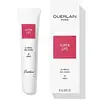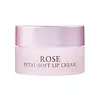What's inside
What's inside
 Key Ingredients
Key Ingredients

 Benefits
Benefits

 Concerns
Concerns

 Ingredients Side-by-side
Ingredients Side-by-side

Diisostearyl Malate
EmollientRicinus Communis Seed Oil
MaskingBis-Diglyceryl Polyacyladipate-2
EmollientC10-30 Cholesterol/Lanosterol Esters
EmulsifyingSimmondsia Chinensis Seed Oil
EmollientGlyceryl Behenate/Eicosadioate
EmollientVitis Vinifera Seed Oil
EmollientCalcium Aluminum Borosilicate
Polyethylene
AbrasiveOctyldodecanol
EmollientStearalkonium Hectorite
Gel FormingDipalmitoyl Hydroxyproline
Skin ConditioningSorbitan Olivate
EmulsifyingTheobroma Grandiflorum Seed Butter
Skin ConditioningIrvingia Gabonensis Kernel Butter
Skin ConditioningPropylene Carbonate
SolventParfum
MaskingHydrogenated Coco-Glycerides
EmollientHydrogenated Microcrystalline Wax
Emulsion StabilisingEthylene/Propylene/Styrene Copolymer
Limonene
PerfumingTriethyl Citrate
MaskingSynthetic Fluorphlogopite
Linalool
PerfumingButylene/Ethylene/Styrene Copolymer
CI 77891
Cosmetic ColorantTocopherol
AntioxidantCI 77491
Cosmetic ColorantPentaerythrityl Tetra-Di-T-Butyl Hydroxyhydrocinnamate
AntioxidantCitral
PerfumingDiisostearyl Malate, Ricinus Communis Seed Oil, Bis-Diglyceryl Polyacyladipate-2, C10-30 Cholesterol/Lanosterol Esters, Simmondsia Chinensis Seed Oil, Glyceryl Behenate/Eicosadioate, Vitis Vinifera Seed Oil, Calcium Aluminum Borosilicate, Polyethylene, Octyldodecanol, Stearalkonium Hectorite, Dipalmitoyl Hydroxyproline, Sorbitan Olivate, Theobroma Grandiflorum Seed Butter, Irvingia Gabonensis Kernel Butter, Propylene Carbonate, Parfum, Hydrogenated Coco-Glycerides, Hydrogenated Microcrystalline Wax, Ethylene/Propylene/Styrene Copolymer, Limonene, Triethyl Citrate, Synthetic Fluorphlogopite, Linalool, Butylene/Ethylene/Styrene Copolymer, CI 77891, Tocopherol, CI 77491, Pentaerythrityl Tetra-Di-T-Butyl Hydroxyhydrocinnamate, Citral
Isononyl Isononanoate
EmollientC10-30 Cholesterol/Lanosterol Esters
EmulsifyingBis-Diglyceryl Polyacyladipate-2
EmollientCera Microcristallina
Emulsion StabilisingPolybutene
Ethylene/Propylene/Styrene Copolymer
Glyceryl Behenate/Eicosadioate
EmollientPrunus Armeniaca Kernel Oil
MaskingButylene/Ethylene/Styrene Copolymer
Ribes Nigrum Seed Oil
EmollientVitis Vinifera Seed Oil
EmollientRosa Damascena Extract
MaskingRosa Damascena Flower Oil
MaskingTocopherol
AntioxidantAscorbyl Palmitate
AntioxidantSilica Silylate
EmollientBenzotriazolyl Dodecyl P-Cresol
UV AbsorberParfum
MaskingPentaerythrityl Tetra-Di-T-Butyl Hydroxyhydrocinnamate
AntioxidantCI 77891
Cosmetic ColorantBHT
AntioxidantPolyglyceryl-2 Triisostearate
EmulsifyingWater
Skin ConditioningTrimethylolpropane Triisostearate
EmollientCI 15850
Cosmetic ColorantCI 15985
Cosmetic ColorantPropyl Gallate
AntioxidantCitronellol
PerfumingGeraniol
PerfumingLimonene
PerfumingIsononyl Isononanoate, C10-30 Cholesterol/Lanosterol Esters, Bis-Diglyceryl Polyacyladipate-2, Cera Microcristallina, Polybutene, Ethylene/Propylene/Styrene Copolymer, Glyceryl Behenate/Eicosadioate, Prunus Armeniaca Kernel Oil, Butylene/Ethylene/Styrene Copolymer, Ribes Nigrum Seed Oil, Vitis Vinifera Seed Oil, Rosa Damascena Extract, Rosa Damascena Flower Oil, Tocopherol, Ascorbyl Palmitate, Silica Silylate, Benzotriazolyl Dodecyl P-Cresol, Parfum, Pentaerythrityl Tetra-Di-T-Butyl Hydroxyhydrocinnamate, CI 77891, BHT, Polyglyceryl-2 Triisostearate, Water, Trimethylolpropane Triisostearate, CI 15850, CI 15985, Propyl Gallate, Citronellol, Geraniol, Limonene
Ingredients Explained
These ingredients are found in both products.
Ingredients higher up in an ingredient list are typically present in a larger amount.
This ingredient is lipid-based synthetic skin-conditioning agent derived from adipic acid and a mixture of fatty acids. It is often called a lanolin substitute.
As an emollient, it helps soften and hydrate the skin. Emollients create a barrier on the skin to trap moisture in.
Due to its fatty acid base, it may not be Malassezia folliculitis safe.
Learn more about Bis-Diglyceryl Polyacyladipate-2We don't have a description for Butylene/Ethylene/Styrene Copolymer yet.
C10-30 Cholesterol/Lanosterol Esters isn't fungal acne safe.
Ci 77891 is a white pigment from Titanium dioxide. It is naturally found in minerals such as rutile and ilmenite.
It's main function is to add a white color to cosmetics. It can also be mixed with other colors to create different shades.
Ci 77891 is commonly found in sunscreens due to its ability to block UV rays.
Learn more about CI 77891We don't have a description for Ethylene/Propylene/Styrene Copolymer yet.
Glyceryl Behenate/Eicosadioate isn't fungal acne safe.
Limonene is a fragrance that adds scent and taste to a formulation.
It's found in the peel oil of citrus fruits and other plants such as lavender and eucalyptus. The scent of limonene is generally described as "sweet citrus".
Limonene acts as an antioxidant, meaning it helps neutralize free radicals.
When exposed to air, oxidized limonene may sensitize the skin. Because of this, limonene is often avoided by people with sensitive skin.
The term 'fragrance' is not regulated in many countries. In many cases, it is up to the brand to define this term. For instance, many brands choose to label themselves as "fragrance-free" because they are not using synthetic fragrances. However, their products may still contain ingredients such as essential oils that are considered a fragrance.
Learn more about LimoneneParfum is a catch-all term for an ingredient or more that is used to give a scent to products.
Also called "fragrance", this ingredient can be a blend of hundreds of chemicals or plant oils. This means every product with "fragrance" or "parfum" in the ingredients list is a different mixture.
For instance, Habanolide is a proprietary trade name for a specific aroma chemical. When used as a fragrance ingredient in cosmetics, most aroma chemicals fall under the broad labeling category of “FRAGRANCE” or “PARFUM” according to EU and US regulations.
The term 'parfum' or 'fragrance' is not regulated in many countries. In many cases, it is up to the brand to define this term.
For instance, many brands choose to label themselves as "fragrance-free" because they are not using synthetic fragrances. However, their products may still contain ingredients such as essential oils that are considered a fragrance by INCI standards.
One example is Calendula flower extract. Calendula is an essential oil that still imparts a scent or 'fragrance'.
Depending on the blend, the ingredients in the mixture can cause allergies and sensitivities on the skin. Some ingredients that are known EU allergens include linalool and citronellol.
Parfum can also be used to mask or cover an unpleasant scent.
The bottom line is: not all fragrances/parfum/ingredients are created equally. If you are worried about fragrances, we recommend taking a closer look at an ingredient. And of course, we always recommend speaking with a professional.
Learn more about ParfumPentaerythrityl Tetra-Di-T-Butyl Hydroxyhydrocinnamate (long name, huh?) is a synthetic antioxidant.
It is used to help stabilize other antioxidants or prevent the color from changing in a product.
As an antioxidant, it helps fight free-radical molecules. Free-radical molecules are capable of damaging our cells and other genetic material. Thus, antioxidants may reduce the signs of aging.
This ingredient is oil-soluble.
Learn more about Pentaerythrityl Tetra-Di-T-Butyl HydroxyhydrocinnamateTocopherol (also known as Vitamin E) is a common antioxidant used to help protect the skin from free-radicals and strengthen the skin barrier. It's also fat soluble - this means our skin is great at absorbing it.
Vitamin E also helps keep your natural skin lipids healthy. Your lipid skin barrier naturally consists of lipids, ceramides, and fatty acids. Vitamin E offers extra protection for your skin’s lipid barrier, keeping your skin healthy and nourished.
Another benefit is a bit of UV protection. Vitamin E helps reduce the damage caused by UVB rays. (It should not replace your sunscreen). Combining it with Vitamin C can decrease sunburned cells and hyperpigmentation after UV exposure.
You might have noticed Vitamin E + C often paired together. This is because it is great at stabilizing Vitamin C. Using the two together helps increase the effectiveness of both ingredients.
There are often claims that Vitamin E can reduce/prevent scarring, but these claims haven't been confirmed by scientific research.
Learn more about TocopherolVitis Vinifera Seed Oil comes from the grape vine. Grape seeds are a byproduct of creating grape juice or wine.
The components of grape seeds have many skin benefits. Research has found it to be antimicrobial and anti-inflammatory. It also contains many potent antioxidants such as Vitamin E , Vitamin C, proanthocyanidins, polyphenols, flavonoids, and anthocyanins. Proanthocyanidin has been shown to help even out skin tone.
Antioxidants help fight free-radical molecules. Free-radical molecules are capable of damaging our cells and other genetic material. Antioxidants help stabilize free-radicals by donating extra electrons. Grape seed extract may help reduce the signs of aging.
The antimicrobial properties of grape seed may help treat acne. However, more research is needed to support this claim.
Grape seed has also been found to help absorb UV rays. Grape seed extract should not replace your sunscreen.
The fatty acids of grape seed oil give it emollient properties. Emollients help soothe and soften your skin by creating a film. This film traps moisture within, keeping your skin hydrated.
Learn more about Vitis Vinifera Seed Oil